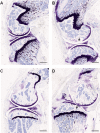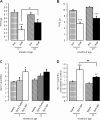Development of monosodium acetate-induced osteoarthritis and inflammatory pain in ageing mice
- PMID: 25971876
- PMCID: PMC4430498
- DOI: 10.1007/s11357-015-9792-y
Development of monosodium acetate-induced osteoarthritis and inflammatory pain in ageing mice
Abstract
Most conditions associated with ageing result from an age-related loss in the function of cells and tissues that maintain body homeostasis. In osteoarthritis (OA) patients, an inadequate response to stress or joint injury can lead to tissue destruction which can result in chronic pain. Here, we evaluated the development of monoiodoacetate (MIA)-induced OA in 3-, 15- and 22-month-old mice and assessed the pain-like behaviours and the spinal microglial changes associated with MIA administration. We observed that in aged mice, nocifensive behaviour was significantly attenuated in comparison to young adults despite similar knee joint pathology. Specifically referred mechanical allodynia associated with the MIA initial inflammatory phase (0-10 days) was significantly attenuated in 22-month-old mice. In contrast, the late phase of MIA-induced mechanical allodynia was comparable between age groups. Significant increase of microglia cell numbers was detected in 3, but not 15- and 22-month-old spinal cords. Furthermore, in the zymosan model of acute inflammation, mechanical allodynia was attenuated, and microglial response was less robust in 22 compared to 3-month-old mice. This study suggests that nocifensive responses to damaging stimuli are altered with advancing age and microglial response to peripheral damage is less robust.
Figures





Similar articles
-
Pain-like behaviour and spinal changes in the monosodium iodoacetate model of osteoarthritis in C57Bl/6 mice.Eur J Pain. 2013 Apr;17(4):514-26. doi: 10.1002/j.1532-2149.2012.00223.x. Epub 2012 Nov 21. Eur J Pain. 2013. PMID: 23169679
-
The Monoiodoacetate Model of Osteoarthritis Pain in the Mouse.J Vis Exp. 2016 May 16;(111):53746. doi: 10.3791/53746. J Vis Exp. 2016. PMID: 27214709 Free PMC article.
-
Monosodium iodoacetate-induced inflammation and joint pain are reduced in TRPA1 deficient mice--potential role of TRPA1 in osteoarthritis.Osteoarthritis Cartilage. 2015 Nov;23(11):2017-26. doi: 10.1016/j.joca.2015.09.008. Osteoarthritis Cartilage. 2015. PMID: 26521748
-
Differences in structural and pain phenotypes in the sodium monoiodoacetate and meniscal transection models of osteoarthritis.Osteoarthritis Cartilage. 2013 Sep;21(9):1336-45. doi: 10.1016/j.joca.2013.06.031. Osteoarthritis Cartilage. 2013. PMID: 23973148 Free PMC article.
-
Decreased calcitonin gene-related peptide expression in the dorsal root ganglia of TNF-deficient mice in a monoiodoacetate-induced knee osteoarthritis model.Int J Clin Exp Pathol. 2015 Oct 1;8(10):12967-71. eCollection 2015. Int J Clin Exp Pathol. 2015. PMID: 26722492 Free PMC article.
Cited by
-
Age-Associated Changes in Knee Osteoarthritis, Pain-Related Behaviors, and Dorsal Root Ganglia Immunophenotyping of Male and Female Mice.Arthritis Rheumatol. 2023 Oct;75(10):1770-1780. doi: 10.1002/art.42530. Epub 2023 Jul 14. Arthritis Rheumatol. 2023. PMID: 37096632 Free PMC article.
-
Association Between Non-spinal Comorbid Medical Conditions and Neuropathic Low Back Pain. - A Further Unravelling of Pain Complexities in the Context of Back Pain.Global Spine J. 2025 May;15(4):1985-1991. doi: 10.1177/21925682241276441. Epub 2024 Aug 12. Global Spine J. 2025. PMID: 39133241 Free PMC article.
-
Senolytic drugs relieve pain by reducing peripheral nociceptive signaling without modifying joint tissue damage in spontaneous osteoarthritis.Aging (Albany NY). 2022 Aug 10;14(15):6006-6027. doi: 10.18632/aging.204204. Epub 2022 Aug 10. Aging (Albany NY). 2022. PMID: 35951358 Free PMC article.
-
Age-Dependent Changes in the Inflammatory Nociceptive Behavior of Mice.Int J Mol Sci. 2015 Nov 18;16(11):27508-19. doi: 10.3390/ijms161126041. Int J Mol Sci. 2015. PMID: 26593904 Free PMC article.
-
Quercetin prevents osteoarthritis progression possibly via regulation of local and systemic inflammatory cascades.J Cell Mol Med. 2023 Feb;27(4):515-528. doi: 10.1111/jcmm.17672. Epub 2023 Feb 1. J Cell Mol Med. 2023. PMID: 36722313 Free PMC article.
References
-
- Bove SE, Calcaterra SL, Brooker RM, Huber CM, Guzman RE, Juneau PL, Schrier DJ, Kilgore KS. Weight bearing as a measure of disease progression and efficacy of anti-inflammatory compounds in a model of monosodium iodoacetate-induced osteoarthritis. Osteoarthr Cartil. 2003;11:821–830. doi: 10.1016/S1063-4584(03)00163-8. - DOI - PubMed
MeSH terms
Substances
LinkOut - more resources
Full Text Sources
Other Literature Sources
Medical
